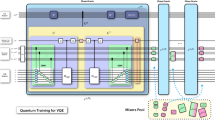Abstract
The key point of introducing quantum genetic algorithm to a quantum backpropagation neural network model is to overcome local stagnation problem which used to be Achilles’ heel. In this paper, we propose a new quantum backpropagation (QBP) model based on the quantum genetic algorithm (QGA) and make simulations with this model to see whether QGA can really upgrade QBP and, in addition, to ensure that both quantum neural networks are better than classical backpropagation (CBP) neural networks from many points of view. Numerical experiments have been built to illustrate the efficiency of the new QBP algorithm over CBP and the original QBP algorithm. However, the proposed model has shown superior results to the rest of models in terms of correction rate and training time. That is to say quantum genetic algorithm-based quantum backpropagation neural network converges earlier than the other two models and that’s why we can reduce the time needed to train.











Similar content being viewed by others
Data availability
All the references cited are available. All data and material considered in this paper are transparent.
Code availability
The authors have used MATLAB as software appliance and a Core i7-4720 laptop as hardware support.
References
Simonyan, K. and Zisserman, A.: Very deep convolutional networks for large-scale image recognition. In: International Conference on Learning Representations (2015)
Ciresan, D., Meier, U., and Schmidhuber, J.: Multi-column deep neural networks for image classification. In: Computer Vision and Pattern Recognition (CVPR), 2012 IEEE Conference on, IEEE, pp. 3642–3649 (2012)
Krizhevsky, A., Sutskever, I., and Hinton, G.E.: Imagenet classification with deep convolutional neural networks. Adv. Neural Inf. Process. Syst. 1097–1105 (2012)
Menotti, D., Schwartz, W.R., Falcao, A.X., Rocha, A.: Deep representations for iris, face, and fingerprint spoofing detection. IEEE Trans. Inf. Foren. Secur. 10(4), 864–879 (2015)
McLoughlin, I., Zhang, H., Xie, Z., Song, Y., Xiao, W.: Robust sound event classification using deep neural networks. IEEE/ACM Trans. Audio Speech Lang. Process. 23(3), 540–552 (2015)
Kouda, N., Matsui, N., Nishimura, H., Peper, F.: Qubit neural network and its learning efficiency. Neural Comput. Appl. 14(2), 114–121 (2005)
Araujo, R.A., Oliveira, A.L.I., Soares, S.C.B.: A quantum-inspired hybrid methodology for financial time series prediction. In: Proceedings of the 2010 International Joint Conference on Neural Networks, pp. 1–8 (2010)
Matsui, N., Kouda, N., Nishimura, H.: Neural networks based on QBP and its performance, Neural networks, 2000. In: IJCNN 2000, Proceedings of the IEEE-INNS-ENNS International Joint Conference on, vol. 3, pp. 247–252 (2000)
Xie, G.J., Zhou, D., Fan, H.Q.: A neural networks model based on quantum gates cell and its application. Syst. Eng. Theory Pract. 5, 113–117 (2005)
Kak, S.C.: On quantum neural computing. Inf. Sci. 83, 143–163 (1995)
Yekta, P.V., Honar, F.J., Fesharaki, M.N.: Modelling of hysteresis loop and magnetic behaviour of Fe–48Ni alloys using artificial neural network coupled with genetic algorithm. Comput. Mater. Sci. 159, 349–356 (2019)
Dutta, T., Dey, S., Datta, S., Das, D.: Designing dual-phase steels with improved performance using ANN and GA in tandem. Comput. Mater. Sci. 157, 6–16 (2019)
Liao, R., Wang, X., Qin, Z.: A novel quantum-inspired genetic algorithm with expanded solution space. In: 2010 Second International Conference on Intellligent Human-Machine Systems and Cybernetics, pp. 192–195 (2010)
Li, P.C., Li, S.Y.: Quantum-inspired evolutionary algorithm for continuous spaces optimization. Chin. J. Electron. 17(1), 80–84 (2008)
Zhao, W., Guo, S., Zhou, Y., Zhang, J.: A quantum-inspired genetic algorithm-based optimization method for mobile impact test data integration. Comput.-Aided Civ. Infrastruct. Eng. 33, 411–422 (2018)
Talbi, H., Batouche, M., Draa, A.: A quantum-inspired evolutionary algorithm for multiobjective image segmentation. Int. J. Math. Phys. Eng. Sci. 1, 109–114 (2007)
Han, K.H., Kim, J.H.: Quantum-inspired evolutionary algorithm for a class of combinatorial optimization. IEEE Trans. Evol. Comput. 6(6), 580–593 (2002)
Han, K.H., Kim, J.H.: Quantum-inspired evolutionary algorithms with a new termination criterion Hε gate, and two-phase scheme. IEEE Trans. Evol. Comput. 8(2), 156–169 (2004)
Angeline, P.J., Saunders, G.M., Pollack, J.B.: An evolutionary algorithm that constructs recurrent neural networks. IEEE Trans. Neural Netw. 5(1), 54–65 (1994)
Floreano, D., Durr, P., Mattiussi, C.: Neuroevolution: from architectures to learning. Evol. Intel. 1(1), 47–62 (2008)
Stanley, K.O., D’Ambrosio, D.B., Gauci, J.: A hypercube-based encoding for evolving large-scale neural networks. Artif. Life 15(2), 185–212 (2009)
Stanley, K.O., Miikkulainen, R.: Evolving neural networks through augmenting topologies. Evol. Comput. 10(2), 99–127 (2002)
Yao, X.: Evolving artificial neural networks. Proc. IEEE 87(9), 1423–1447 (1999)
Acknowledgements
This work was supported by the National Program on Key Project for Frontier Research on Quantum Information and Quantum Optics of Democratic People’s Republic of Korea.
Funding
There is no funding.
Author information
Authors and Affiliations
Contributions
N-CK is the project manager. He designed the model and checked the accuracy of calculations. I-HC performed theoretical calculations and numerical calculations. She also analyzed the results and contributed to preparation of the manuscript. M-CK and J-SR checked the correctness of the theoretical calculations and the analysis. R-MH and T-GH checked the results of numerical calculations, and IH checked the validity of the set of parameters.
Corresponding author
Ethics declarations
Conflict of interest
The authors claim that they have no conflict of interest.
Consent to participate
All authors consent to participate.
Consent to publish
All authors consent to participate.
Ethical approval
The submitted work is original and has not been published elsewhere in any form or language (partially or in full).
Additional information
Publisher's Note
Springer Nature remains neutral with regard to jurisdictional claims in published maps and institutional affiliations.
Supplementary Information
Below is the link to the electronic supplementary material.
Rights and permissions
Springer Nature or its licensor (e.g. a society or other partner) holds exclusive rights to this article under a publishing agreement with the author(s) or other rightsholder(s); author self-archiving of the accepted manuscript version of this article is solely governed by the terms of such publishing agreement and applicable law.
About this article
Cite this article
Choe, IH., Kim, GJ., Kim, NC. et al. Can quantum genetic algorithm really improve quantum backpropagation neural network?. Quantum Inf Process 22, 154 (2023). https://doi.org/10.1007/s11128-023-03858-w
Received:
Accepted:
Published:
DOI: https://doi.org/10.1007/s11128-023-03858-w




